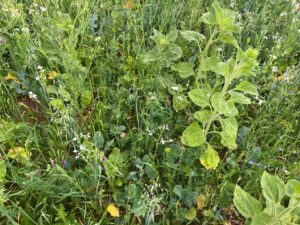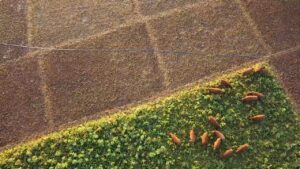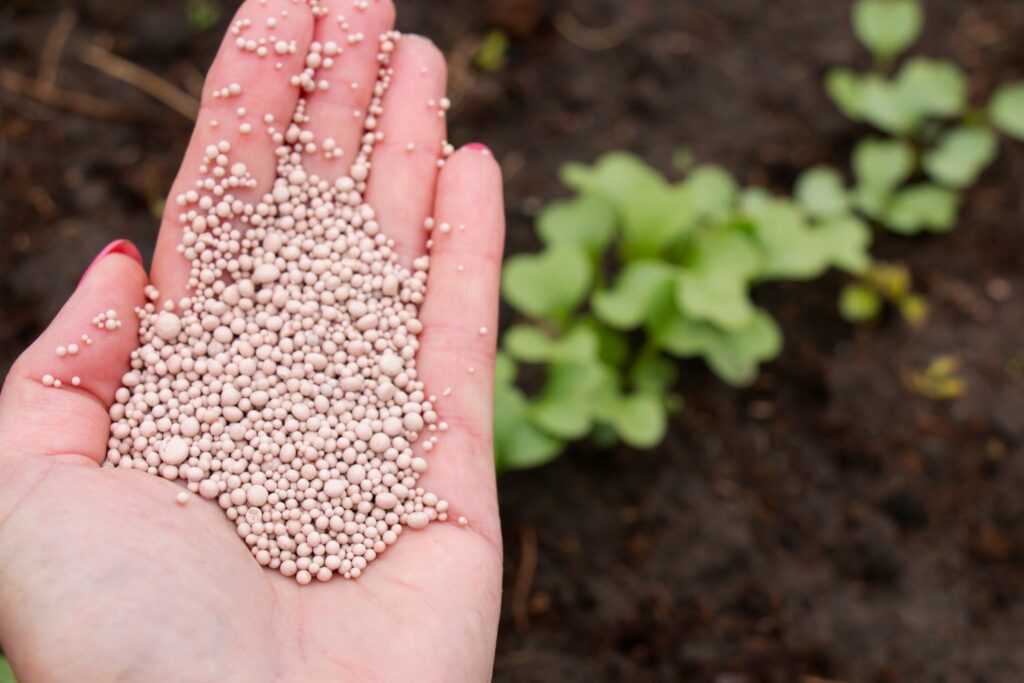Building soil fertility is central to solving the fertiliser crisis, group says
25th January 2023
Farmers and researchers at the Oxford Real Farming Conference 2023 discussed various practical and cost-effective ways of increasing fertility and nutrient availability in the soil while reducing or eliminating the need for artificial fertilisers.
The meeting, featuring inspiring presentations from speakers involved in farmer-led research, aimed to find solutions to the ongoing fertiliser crisis that continues to impose considerable strain on the agricultural sector.
Jerry Alford, senior farming advisor at the Soil Association, opened the session by introducing the Innovative Farmers network and its role in creating more on-farm fertility production to reduce the scale of fertiliser inputs.
Putting the soil before the product can go a long way
Offering a unique perspective on the issue at hand, market gardener Amelia Lake provided delegates with detailed insight into the operations of her small but mighty Real Food Garden business in Cornwall.
From humble beginnings starting out with less than two acres of land, Ms Lake’s market garden grew into a thriving business selling produce via an on-site farm shop and veg box scheme. Between June and January each year, an impressive 55-60 veg boxes are produced per week, which is made possible by the smarter utilisation of available space.
Ms Lake explained that, by taking a restorative and holistic approach to soil health, she and her partner Chloe have been able to build resilience in the soil over time and increase what the ground is able to give.
Almost from the beginning, the team of two have been involved with The Soil Carbon project, now known as Farm Net Zero, which works in collaboration with the Farm Carbon Toolkit. As a result, they have been better able to assess and monitor the soil, which has helped to demonstrate the viability of their approach.
“Through our carbon calculator, we know we’re locking in 31 tons of carbon every year, and the soil is sequestering 19 tonnes of that,” Ms Lake said. She added that there has also been a 1.1% increase in soil organic matter per annum, which is about ten times the average rate.
Nutrient density of the fresh produce is also being measured using a spectrometer and compared to organic products on retailer shelves. Ms Lake found the nutrient density of her produce to be consistently higher, which she attributes to the healthy soil foodweb at the garden.
“Instead of thinking about the product, we’re thinking about the soil,” she pointed out, saying the approach has been highly productive for the business so far.
With regards to increasing soil fertility, Ms Lake and her partner are conducting a two-year fertility building programme on designated areas, which involves rotating brassicas with non-brassica crops. The aim is to ultimately build organic matter and resilience in the soil through plant root growth as opposed to using compost.
Ms Lake also addressed tackling food waste at the Real Food Garden, saying she managed to close the loop on food waste by cultivating crop residue back into the soil and using chickens, sheep and pigs to turn it into manure.
Moreover, the garden has been using green waste compost (GWC) since its launch, which is high in carbon and a valuable food source for the food web. Not only does it enhance soil structure and fertility, but also improves soil pH which has been really valuable, Ms Lake explained.
However, GWC also has its downsides, in that it comes from off-farm and the labour to spread it is really significant for the business. Therefore, to make sure every kg of material is paying its weight, Ms Lake enrolled in a field lab led by Innovative Farmers and Farm Net Zero to find out if there is a way to increase biological activity in the compost.
The trial involves comparing GWC inoculated with hedge soil, home-made compost and wood chip material with an uninoculated control and looking at differences in crop yield and quality. Ms Lake said the aim is to develop a better compost in the same volume, or in other words, to use less of the same material with better results.
The results of the field lab will be released following the 2023 growing season.
Untangling controversies around sheep and red clover
Gillian Preece, livestock farmer and senior agri consultant for ADAS, shared details of an Innovative Farmers project conducted to debunk a long-standing myth in the industry relating to mating breeding ewes on fields containing red clover (RC).
According to Ms Preece, the current recommendation is not to mate sheep on RC due to the legume’s phytoestrogen content. However, anecdotal evidence has so far indicated the practice shouldn’t cause issues, which goes directly against industry guidelines.
In the hope of uncovering the true facts and potentially remove barriers to sheep farmers rearing on RC, Ms Preece applied and got accepted to do an Innovative Farmers project investigating fertility issues in ewes relating to RC.
The trial involved four farms across the West Midlands and into Wales that have existing herbal leys containing RC and sheep of the same age, breed and history. Three weeks prior to tupping time, the flocks were each split into two groups, with one mating on sward containing RC and the other on non-RC.
Sward assessments revealed quite a large variation in RC content between the four farms. Ms Preece explained that the farmers have all planted herbal leys to comply with Countryside Stewardship guidelines, which require a minimum of 10% RC content. However, because they are in different years of establishment, the RC content of swards was uneven.
The results of the trial revealed no negative effects on ewe fertility when grazing swards containing an average of 18% RC (by fresh weight). Scanning results showed a 170% average scanning percentage in ewes on a grass-only diet versus 181% in ewes on RC. There was also no significant difference in barren rate between the two groups, Ms Preece added.
While the results indicate farmers can have confidence mating sheep on RC, Ms Preece pointed out the evidence is still insufficient to cause a change of attitude in the industry as the trial was conducted on only four farms and wasn’t fully controlled.
Therefore, she highlighted the need for further investigation so farmers and in particular vets, feed advisors and seed reps can have more confidence in the results.
Putting the trial into perspective, Ms Preece said: “There’s an increasing focus on the use of legumes within grassland systems to reduce nitrogen use and also to capitalise on environmental stewardship opportunities.
“We need to see more legumes be grown so we can ultimately reduce that reliance on artificial nitrogen within red meat production.”
Working towards improved nutrient cycling through better soil health
Next up, Matthew Izod, who farms a 500-acre conventional arable farm with his father just outside Chipping Norton, talked delegates through a couple of Innovative Farmers trials he has been involved in and the lessons learned so far.
The first trial, sponsored by Thames Water, is looking at the effects of a no-till & cover crop system on soil nutrient availability over a five-year period. While improvement has been negligible so far, Mr Izod noted the system takes a bit of time to work and is eager to see the results at the end of the trial.
The second project backed by AHDB tested the effects of a living mulch clover understory on the 2021 cropping season. According to Mr Izod, the clover established really well and acted as an effective weed deterrent for the cash crop as well as improving soil structure and providing ground cover after harvest.
Unfortunately, the mulch caused a major yield penalty, and so improved methods are needed to control it in the next trial, Mr Izod concluded.
Like many farmers, Mr Izod has been working to reduce the amount of fertiliser applied due to the major cost it incurs. Instead of the usual 200-250kg product/ha a year, the farm now uses 160 kg of product/ha with a reduced rate of liquid nitrogen. To increase the efficiency of fertiliser, Mr Izod also adds some Boost to the mix, which is a carbon and molasses-based fertiliser improver.
Tissue sampling is also carried out throughout the season to assess the nutritional needs of the crop. In addition, Mr Izod tested the soil for nutrient availability, which led to some profound realisations.
The results returned from the lab revealed that the amount of total nutrients present in the top layers of the soil (specifically potash, phosphorus and sulphur) is 20 to 200 times higher than the amount available to crops.
Therefore, instead of buying I artificial products, farmers need to focus on building fertility in the soil and making those nutrients available to the crop, Mr Izod pointed out. He added that nutrient cycling in the soil can be improved via the use of cover crops, especially legumes, as well as different drilling and cultivation strategies.
Improving rotation and integrating livestock on cover crops will be part of the solution, Mr Izod continued, saying they now cover 100% of the farm during winter. Sheep has been brought on farm in recent years to graze the cover crops and build soil fertility, and Mr Izod is looking to expand the size of his exiting flock.
Looking into the future, he said the ultimate goal is to have “a system where the livestock is working for me and the crops are working side-by-side.” Lastly, he reminded farmers while there is no quick fix to the fertiliser crisis, small changes can make a big difference.
The benefits of diverse forage crops for livestock and soil health
Last but not least, Sarah Whaley from the Farming Wildlife Advisory Group (FWAG) shared some fascinating findings from an ongoing Innovative Farmers field lab. In the role of project coordinator, she has been working closely with the four participating farmers in Devon and Somerset, as well as soil scientists and ecologists involved in the project.
Outlining the background to the trial, Ms Whaley said many farmers are dissatisfied with the current system of mono-culture forage crops for outwintering livestock as they provide minimal benefit to the soil and can actually deplete its health and cause structural issues like compaction.
Moreover, mono crops can be more susceptible to pests and diseases, requiring higher levels of chemical and fertiliser input. In addition, forage crops like kale provide insufficient fibre for sustaining livestock throughout winter, and farmers will need to supplementary feed hay which can be destructive to fields and adds to farmer workload.

A closer look to the 16-species mix on a trial field.
Ms Whaley pointed out that, although mono-culture winter brassicas produce reasonably reliable and low-cost forage, they under-deliver for soil health, water and the wider environment, animal welfare, public perception and farmer wellbeing. Therefore, the aim of the field lab has been to find and validate a diverse species mix solution as an alternative to winter grazing kale.
The trial was set up in May 2022 on two organic and two conventional farms in the South West. Each farm was required to drill 4 ha of a 16-species seed mix next to 4 ha of their usual winter forage crop.
The farmers selected for various traits in the seed mix, such as for soil benefit, winter hardiness, ecological benefit and birdseed. The full list of crops included in the diverse mix can be found on the Innovative Farmers website.
Cattle were weighed and body condition scored before the trial and have been monitored closely since the start of winter grazing in early November 2022. Soil sampling and testing was also performed before the trial and VESS scoring, earthworm counts, and rhizosheath development monitoring have also been carried out at regular intervals.
According to Ms Whaley, observations so far have shown significant improvements in soil health and biodiversity on diverse mix fields compared to kale.
The greater root biomass of the diverse mix has produced a much-improved soil structure on trial fields, with soil pit tests revealing an ideal chocolate cake-like texture. In contrast, the ground was much more compacted on the kale side and also had poor drainage, causing issues with water runoff and erosion.
In terms of biodiversity, the diverse mix attracted a greater number of invertebrates including pollinator species, while diversity in the kale crop was largely limited to cabbage butterflies.
Livestock has been doing well on both sides so far, but have appeared more content on the diverse mix fields, Ms Whaley said. She added the ground appears to be holding up better under the mixed plot, which helps keep the animals out of the mud and working less hard.

Even though the multispecies mix has largely been grazed down on triallist Richard Stanbury’s farm, the first signs of regrowth are already evident.
While all farms have moved through their mixed species plots faster than kale and had to provide supplementary hay, regrowth is already happening on mixed fields and farmers are hoping for a spring bite. Time will tell if the seed mix also offers economic benefits alongside soil health and biodiversity improvement, and Ms Whaley said there is still a lot to learn.
With regards to the fertiliser crisis, Ms Whaley suggested farmers should think of it as an opportunity rather than a hindrance.
“If I said, ‘what is the fertiliser crisis,’ many people would say ‘well, it’s the cost of fertiliser,’ but actually, the crisis is we’re using far too much of it. So, it’s our addiction to fertiliser that is the crisis,” she said.
Ms Whaley believes the solution starts with the soil and farmers working together with nature rather than against it: “We need to look at our farms in a much more holistic way and stop micro-managing every little aspect of a biological living system,” she concluded.

